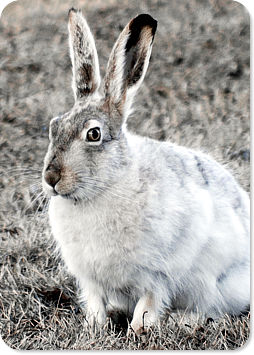 Image: Adam Lowe, Wikimedia Commons. Image: Adam Lowe, Wikimedia Commons.Late snow fine for us, big trouble for rabbits.(Published in the Winnipeg Free Press, Nov. 5, 2000) Well, we made it through another Halloween without snow on the ground. At this time of year the odds of waking up to a winter-wonderland increase daily. We humans can take the advent of snow on the ground in stride; I can put the rake and lawnmower away and get out the shovel at the same time, but the date that the first snows arrive is a bigger deal for many animals. That came to mind the other day. My dog and I were taking advantage of one of Winnipeg's off-leash parks. Out in the middle of the field, a strange white object caught my eye. From a distance, it looked like a white plastic bag lying in the grass. I walked toward it. As I got to within 30 m, the "bag" came alive and off bounded a jack rabbit. The sudden motion caught my dog's eye and away he went. (Yes, I know, I'm not supposed to let my dog harass wildlife, but there wasn't lot I could do about it.) At first the rabbit bounded along seemingly unaware that my dog was on its tail. As the dog got closer the rabbit sped up and for a second or two it maintained an even distance ahead while my dog, who's no slouch, reached top speed. Then the rabbit cranked it up and - VOOM! - was gone. It sped across the field, under a fence and disappeared. I think I saw my dog's jaw drop open, then he slowed to a halt, panting. Just like roadrunner and coyote, I thought. Now, I wasn't surprised to see a white-tailed jack rabbit (Lepus townsendii) in the city. They're common in southern Manitoba and urban areas are often good habitat for wildlife. "Seeing" the rabbit before it bolted was a little unusual. A jack rabbit's first line of defense is "not being seen". When resting they crouch down and flatten out, ears back, so that they are only a bump on the landscape. If discovered they use their speed (up to 60 kph!) to evade predators, but they'd rather not run. I'd noticed the rabbit in the first place because of one of its adaptations for winter; it was growing a white coat to replace its mottled brown summer coat. A white coat is great camouflage against a snowy background, just as the brown helps it hide in summer. The winter coat is white because the hairs contain no pigments. Physiologically, that's a neat trick; turning off the production of dark pigments, called melanins, when the winter coat grows, then turning it back on for the summer coat. (Think of the possibilities if someone figured out how to turn on melanin production in humans: no grey hair!) Jack rabbits and other mammals that turn white for winter do so at a set time each year. Growing a new coat takes several weeks and is triggered by decreasing day length as winter approaches. Jack rabbits have evolved to be changing to white right about the average date when our first snowfalls occur. Now, the one I'd seen may have changed its coat a bit early, but there's always a lot of variation in nature, some will be early, others late. The unpredictability of Manitoba winters makes it a bit dicey for the rabbits each fall. Early snows can catch them still brown, while late snow cover means white rabbits in brown fields. Either way they are at greater risk. Owls, foxes and coyotes gain an advantage if they can spot their prey from far off and plan their attacks. It takes more than pure speed to catch a jack rabbit. Could global warming and a change to our average snow cover dates be harmful to jack rabbits? Well, perhaps for a while. Natural selection would begin to work on the rabbit population and those that turned white too early, or stayed white too late in the spring would be subject to greater pressure from predators. Soon the timing of the coat changes would be shifted to reflect the new average dates of snow cover and snow melt. Nature can adapt to change, even if it's human induced changes to the environment. Thanks for reading! Got to the: < Previous Column | What's Outdoors Front Page | Next Column >
|
||
|
For more on this topic, here's some articles in NatureNorth.com: Makin' Tracks | Tracks in the Classroom | Tracks in the Snow |
||
| You can help NatureNorth produce more great articles with a secure donation through PayPal. Our Google Adsense ads pay our server costs, but that's about it. To learn more follow this link: Support NatureNorth. Thank-you! | |
Return to the: NatureNorth.com Front Page
Or pick a seasonal issue to visit:
